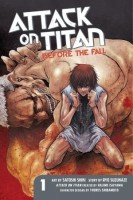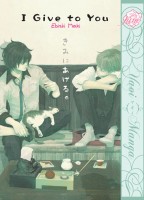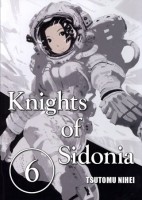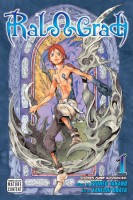My News and Reviews
Last week ended up being surprisingly busy here at Experiments in Manga. The most recent manga giveaway was posted, and there’s still some time left to enter for a chance to win a copy of the new edition of Shohei Manabe’s Smuggler. All you have to do is tell about your favorite assassin in manga. Last week I also posted my review of Hinoki Kino’s manga No. 6, Volume 5. I already knew going into the series that I liked the characters and story, having seen the No. 6 anime, but each volume of the manga is progressively stronger than the last. Over the weekend, I posted February’s Bookshelf Overload for those of you who are interested in that sort of thing. Also over the weekend, I reviewed Real, Volume 1 by Takehiko Inoue. I honestly believe Real to be one of the best manga currently being released in English. The review is part of what I’m calling “Manga March Madness.” Each weekend in March I will be posting a review for another volume of Real. At least that’s the plan. We’ll see if I can pull it off or not.
On to other interesting thing online! The Guys with Pencils podcast posted the second part of their interview with TCAF-founder Chris Butcher. Organization Anti-Social Geniuses has some Advice on Manga Lettering, From Manga Letterers. Khursten Santos wrote about The Silence on Josei Manga on Otaku Champloo, and had some feedback and followup to the post show up on Tumblr. Finally, the Comics Book Legal Defense Fund has an interesting article about the impact government regulations can have on creative freedom—History Repeats Itself: How Korean Manwha Met the Same Fate as American Comics
Quick Takes
 Attack on Titan: Before the Fall, Volume 1 written by Ryo Suzukaze and illustrated by Satoshi Shiki. Set some seventy years before the main events of Hajime Isayama’s original Attack on Titan manga, Before the Fall is based on a series of light novels by Ryo Suzukaze (which Vertical will begin releasing later this year). Despite having a different author than the original manga, Before the Fall fits right in with Isayama’s worldbuilding and the tone set by Attack on Titan—there is still plenty of fear and darkness. The most striking difference, which didn’t come at all as a surprise, is that the artwork in Before the Fall is much stronger overall. The story follows Kuklo, a young man who, due to the unusual circumstances of his birth, is feared, abused, and reviled by those around him. It’s not pretty. People who have read the original Attack on Titan will have a slightly better understanding of the world than those who haven’t, but so far Before the Fall seems to stand quite well on its own. Before the Fall has a lot of potential; I look forward to seeing how it develops.
Attack on Titan: Before the Fall, Volume 1 written by Ryo Suzukaze and illustrated by Satoshi Shiki. Set some seventy years before the main events of Hajime Isayama’s original Attack on Titan manga, Before the Fall is based on a series of light novels by Ryo Suzukaze (which Vertical will begin releasing later this year). Despite having a different author than the original manga, Before the Fall fits right in with Isayama’s worldbuilding and the tone set by Attack on Titan—there is still plenty of fear and darkness. The most striking difference, which didn’t come at all as a surprise, is that the artwork in Before the Fall is much stronger overall. The story follows Kuklo, a young man who, due to the unusual circumstances of his birth, is feared, abused, and reviled by those around him. It’s not pretty. People who have read the original Attack on Titan will have a slightly better understanding of the world than those who haven’t, but so far Before the Fall seems to stand quite well on its own. Before the Fall has a lot of potential; I look forward to seeing how it develops.
 I Give to You by Ebishi Maki. As far as I can tell, I Give to You is Maki’s first and currently only boys’ love manga. It’s not a typical boys’ love story, either. The focus is very much on the characters themselves and their personal struggles and less on romance. The manga addresses what it means to be normal and lead a normal life, which isn’t an option for either of the leads. Ryoichi is being pursued by debt collectors after his ex-boyfriend defaults on a loan they co-signed together. He takes shelter from a storm in a teahouse run by Ren, another young man with a past he’d like to put behind him. The two are very different—despite his financial worries, Ryoichi tends to be fairly warm and happy-go-lucky while Ren is cooler and much more reserved. In the beginning, it’s Ryoichi who needs help and acceptance from Ren, but by the end of I Give to You their roles have almost completely reversed. The evolution of their relationship happens so slowly and naturally over the course of the manga that I was quite impressed with how it was handled. I would definitely be interested in reading more of Maki’s manga.
I Give to You by Ebishi Maki. As far as I can tell, I Give to You is Maki’s first and currently only boys’ love manga. It’s not a typical boys’ love story, either. The focus is very much on the characters themselves and their personal struggles and less on romance. The manga addresses what it means to be normal and lead a normal life, which isn’t an option for either of the leads. Ryoichi is being pursued by debt collectors after his ex-boyfriend defaults on a loan they co-signed together. He takes shelter from a storm in a teahouse run by Ren, another young man with a past he’d like to put behind him. The two are very different—despite his financial worries, Ryoichi tends to be fairly warm and happy-go-lucky while Ren is cooler and much more reserved. In the beginning, it’s Ryoichi who needs help and acceptance from Ren, but by the end of I Give to You their roles have almost completely reversed. The evolution of their relationship happens so slowly and naturally over the course of the manga that I was quite impressed with how it was handled. I would definitely be interested in reading more of Maki’s manga.
 Knights of Sidonia, Volumes 6-7 by Tsutomu Nihei. For most of Knights of Sidonia, it has been the Gauna who have been adapting and evolving by adopting human strategies, techniques, and even form. In these volumes, it’s the humans who have begun to apply the abilities and characteristics of the Gauna to their own technologies, creating terrifying and powerful human-Guana hybrids in the process. Understandably, not everyone is comfortable with these developments, but humanity is running out of options if it wants to survive. Knights of Sidonia has this odd mix of comedy and creepiness that somehow works. Although by this point in the series he has largely been accepted by the rest of the population of Sidonia and even has a few romantic interests, Nagate continues to be incredibly awkward socially. Because of this he still has a tendency to unintentionally create quite a commotion, often with humorous results. At the same time, Knights of Sidonia is also a horror manga. The Gauna, and now the hybrids as well, have very disconcerting designs that can be both grotesque and beautiful.
Knights of Sidonia, Volumes 6-7 by Tsutomu Nihei. For most of Knights of Sidonia, it has been the Gauna who have been adapting and evolving by adopting human strategies, techniques, and even form. In these volumes, it’s the humans who have begun to apply the abilities and characteristics of the Gauna to their own technologies, creating terrifying and powerful human-Guana hybrids in the process. Understandably, not everyone is comfortable with these developments, but humanity is running out of options if it wants to survive. Knights of Sidonia has this odd mix of comedy and creepiness that somehow works. Although by this point in the series he has largely been accepted by the rest of the population of Sidonia and even has a few romantic interests, Nagate continues to be incredibly awkward socially. Because of this he still has a tendency to unintentionally create quite a commotion, often with humorous results. At the same time, Knights of Sidonia is also a horror manga. The Gauna, and now the hybrids as well, have very disconcerting designs that can be both grotesque and beautiful.
 Ral Ω Grad, Volumes 1-4 written by Tsuneo Takano and illustrated by Takeshi Obata. The primary reason I decided to read Ral Ω Grad was because I’m a fan of Obata’s artwork. Ral Ω Grad is a loose adaptation of the 2006 video game Blue Dragon. The manga definitely has a fantasy RPG feel to it—a young hero with special abilities fights against the destruction of the world by gathering together a party of other gifted individuals around him—but familiarity with Blue Dragon isn’t at all necessary to understand what’s going on. Generally, Ral Ω Grad manages to be vaguely entertaining even though it’s breaking no new ground. I found that I enjoyed the series more when I approached it as a parody rather taking it too seriously. (I’m pretty sure it wasn’t intended to be a parody, though…) Ral’s motivation for saving the world? Because he loves women. And boobs. Consequently, there’s fanservice and groping aplenty, but Ral spends quite a bit of his time running around mostly naked, too. In the end, the series’ highlight really is Obata’s artwork, which is consistently excellent. The story, sadly, is less engaging.
Ral Ω Grad, Volumes 1-4 written by Tsuneo Takano and illustrated by Takeshi Obata. The primary reason I decided to read Ral Ω Grad was because I’m a fan of Obata’s artwork. Ral Ω Grad is a loose adaptation of the 2006 video game Blue Dragon. The manga definitely has a fantasy RPG feel to it—a young hero with special abilities fights against the destruction of the world by gathering together a party of other gifted individuals around him—but familiarity with Blue Dragon isn’t at all necessary to understand what’s going on. Generally, Ral Ω Grad manages to be vaguely entertaining even though it’s breaking no new ground. I found that I enjoyed the series more when I approached it as a parody rather taking it too seriously. (I’m pretty sure it wasn’t intended to be a parody, though…) Ral’s motivation for saving the world? Because he loves women. And boobs. Consequently, there’s fanservice and groping aplenty, but Ral spends quite a bit of his time running around mostly naked, too. In the end, the series’ highlight really is Obata’s artwork, which is consistently excellent. The story, sadly, is less engaging.
